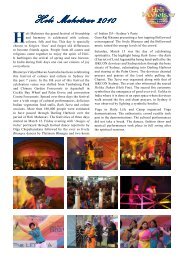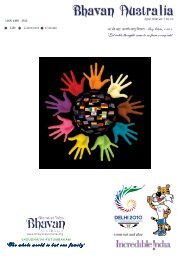The whole world is but one family - Bharatiya Vidya Bhavan Australia
The whole world is but one family - Bharatiya Vidya Bhavan Australia
The whole world is but one family - Bharatiya Vidya Bhavan Australia
You also want an ePaper? Increase the reach of your titles
YUMPU automatically turns print PDFs into web optimized ePapers that Google loves.
Buddh<strong>is</strong>m adopts some Tao<strong>is</strong>t principles. ‘Chan’<br />
<strong>is</strong> Dhyana in Sanskrit and the word zen <strong>is</strong> derived<br />
from it. Zen and dhyana are contemplation, as an<br />
observer. Zen <strong>is</strong> the Japanese word for chan.<br />
During the 6th century BC, the time of Buddha,<br />
the contemporary of Lao Tsu and Confucius,<br />
their respective thoughts became popular and<br />
these were <strong>but</strong> readaptations of traditional Vedic<br />
thinking. Tao<strong>is</strong>m has not made any innovation in<br />
the esoteric and initiatic domains nor Confucian<strong>is</strong>m<br />
made any in the esoteric and social domains. It<br />
appears that 5000 years ago, the ancient Vedic<br />
religion (if we may call it so) ex<strong>is</strong>ted the <strong>world</strong><br />
over and th<strong>is</strong> <strong>is</strong> the traditional bas<strong>is</strong> for Tao<strong>is</strong>t,<br />
Confucian or Zen philosophies. <strong>The</strong> Hindu influence<br />
<strong>is</strong> very strong in Tao<strong>is</strong>m and Confucian<strong>is</strong>m and<br />
Buddh<strong>is</strong>t influence came about much later.<br />
Rene Guenon mentions in h<strong>is</strong> book (<strong>The</strong> Great<br />
Triad) that the Tien-Ti-fen (Heaven, earth and man)<br />
<strong>is</strong> not the same as the Hindu Trinity, creation,<br />
preservation and destruction represented by<br />
Brahma, V<strong>is</strong>hnu and Shiva. One cannot agree<br />
with th<strong>is</strong> thinking since it <strong>is</strong> the Vedic religion<br />
which ex<strong>is</strong>ted 5,000 years ago, that has been the<br />
inspiration for Far Eastern and Western Religions.<br />
In fact it <strong>is</strong> the emergence of these religions that<br />
necessitated naming of the Vedic religion as Hindu<br />
religion by Swami Vivekananda. <strong>The</strong> word Hindu<br />
appeared as the derivative of Sindhu river in the<br />
north through which the Moghuls and Alexander<br />
came to India. Earth can be considered as creation,<br />
man can be considered as preservation and heaven<br />
can be considered as destruction (regeneration).<br />
Actually there <strong>is</strong> no destruction, <strong>one</strong> <strong>is</strong> supposed to<br />
attain heaven on death. In fact, there <strong>is</strong> no birth or<br />
death. <strong>The</strong>se are only organic manifestations of the<br />
universal Shakti through the atman. Without the<br />
atman or soul, no life <strong>is</strong> possible. In Isa Upan<strong>is</strong>had :<br />
it says :<br />
“lsa vasyam idam sarvam yat kinchit jagatyam iagat”<br />
Anything that moves in th<strong>is</strong> Earth, know that Isa<br />
resides, i.e., Isa as Atman <strong>is</strong> a manifestation of the<br />
infinite. In fact, in dhyana or chan or zen <strong>one</strong> can<br />
identity <strong>one</strong>self with the infinite and the feeling of<br />
identity with the body will d<strong>is</strong>appear.<br />
Chr<strong>is</strong>tian equivalents to the Vedic triads:<br />
Holy spirit - purusha - Heaven<br />
<strong>The</strong> virgin - prakriti - Earth<br />
Sat - Chit - Ananda<br />
It <strong>is</strong> clear that the Vedic Religion influenced<br />
Chr<strong>is</strong>tianity.<br />
<strong>The</strong> Egyptian triad falls in the category of the<br />
Chr<strong>is</strong>tian Father, Mother and Son. (Osir<strong>is</strong>, Is<strong>is</strong><br />
and Horus). Heaven (Tien) and Earth (Ti) are<br />
ind<strong>is</strong>solubly united in the “Great Extreme”<br />
(Tai chi). In it both are united in a state of non-<br />
38 | <strong>Bhavan</strong> <strong>Australia</strong> | February 2012<br />
separation or non-duality. It <strong>is</strong> “Pure Being” and<br />
<strong>is</strong> identical to the “Great Unity” (Tai I). Tai chi as<br />
Unity (being) presupposes (Wu chi), non-being.<br />
Th<strong>is</strong> corresponds to Ishwara and Parabrahma or<br />
Apara Brahma and Para Brahma.<br />
<strong>The</strong>re <strong>is</strong> no dual<strong>is</strong>m in the Far Eastern Religions<br />
as they are <strong>but</strong> derived from the Vedic Religion.<br />
In the Vedic Religion there <strong>is</strong> no duality. Advaita<br />
<strong>is</strong> non-dual. But in the Vedic tradition and<br />
legends, the starting point <strong>is</strong> the dual<strong>is</strong>t <strong>is</strong>hwara<br />
and Brahma. Th<strong>is</strong> <strong>is</strong> because advaita cannot <strong>but</strong><br />
be restricted to a small group of elite students,<br />
the true sanyasins of the Ramakr<strong>is</strong>hna and<br />
other Ashramas. <strong>The</strong> common man and even<br />
the educated man would find it very difficult to<br />
understand Advaita. It <strong>is</strong> only in the process of<br />
evolution a small group of people reach a mental<br />
state where the principles of Advaita or nondual<strong>is</strong>m<br />
<strong>is</strong> understood. It <strong>is</strong> prec<strong>is</strong>ely for th<strong>is</strong><br />
reason that saints like Ramanuja propounded<br />
V<strong>is</strong><strong>is</strong>htavaita and its derivatives. <strong>The</strong> common man<br />
will understand if he <strong>is</strong> told that God <strong>is</strong> separate<br />
from him. In Advaita the Godhead <strong>is</strong> identified with<br />
the individual, and all living beings are part of the<br />
<strong>one</strong> Brahman and not different from it.<br />
In Bhagawad Gita, Sri Kr<strong>is</strong>hna solves the problem<br />
of the indec<strong>is</strong>ive Arjuna and thereby evolves a<br />
great way of life for all peoples of the <strong>world</strong>. For<br />
the common man the Bhakti yoga, for the educated<br />
man, Karma yoga and for the evolved <strong>one</strong>s, Jnana<br />
yoga. All these paths lead to the merger into the<br />
infinite Brahman.<br />
Let us take microcosm and macrocosm. Microcosm<br />
can be taken as the individual: Atman and<br />
Macrocosm as the universal ‘Soul’ or Atman.<br />
<strong>The</strong> <strong>one</strong> <strong>is</strong> the manifestation of the other and are<br />
naturally non-exclusive. Similarly the individual<br />
has all the manifestations of the <strong>whole</strong> as he <strong>is</strong> the<br />
building block for the <strong>family</strong>, society, nation and<br />
the <strong>world</strong> at large. Without the macrocosm or the<br />
paramatman, there <strong>is</strong> no microcosm, (Jivatman)<br />
a manifestation of the paramatman. <strong>The</strong> infinite<br />
encompasses Unity as a manifestation. Just as man<br />
<strong>is</strong> the intermediate connection between Heaven<br />
and Earth or Purusha and Prakriti, so <strong>is</strong> h<strong>is</strong> intellect<br />
and mental faculty (manas), the connection<br />
between the macrocosm and microcosm,<br />
menti<strong>one</strong>d earlier.<br />
Let us look at the Yang and Yin of the Far Eastern<br />
Tradition. Everything active, positive and<br />
masculine <strong>is</strong> yang. Everything passive, negative<br />
and feminine <strong>is</strong> yin. It <strong>is</strong> almost certain that the<br />
word yang <strong>is</strong> derived from Linga and word yin<br />
from the word yoni, of the Vedic religion. In<br />
both cases the connotation <strong>is</strong> the same. <strong>The</strong>y<br />
are both complementary and ex<strong>is</strong>t only in their<br />
manifestation. We may call these pairs of opposites<br />
as dwandwas, similar to light and shade, heaven<br />
and earth, prakrithi and purusha and so on. <strong>The</strong><br />
feminine aspects of these pairs of opposites









